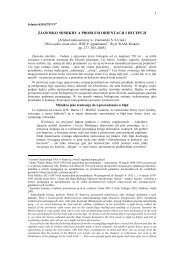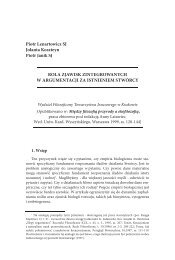the body-mind dichotomy a problem or artifact? - Piotr Lenartowicz SJ
the body-mind dichotomy a problem or artifact? - Piotr Lenartowicz SJ
the body-mind dichotomy a problem or artifact? - Piotr Lenartowicz SJ
You also want an ePaper? Increase the reach of your titles
YUMPU automatically turns print PDFs into web optimized ePapers that Google loves.
9<br />
The integration of different f<strong>or</strong>ms of purely physical dynamism is <strong>the</strong> basic, common<br />
and omnipresent trait of life (including <strong>the</strong> activity of <strong>the</strong> „human <strong>mind</strong>”). It is <strong>the</strong> only<br />
activity which really necessitates a new causal solution. Cognitive activity and <strong>the</strong><br />
freedom of deliberate actions not seem to involve anything m<strong>or</strong>e than what was already<br />
required – that is an integrating agency (of a given kind), capable of selecting and<br />
exploiting a raw material, be it physical <strong>or</strong> cognitive (prepared by <strong>the</strong> sense <strong>or</strong>gans).<br />
Now we shall turn to <strong>the</strong> second arbitrary, speculative step, which produces <strong>the</strong> <strong>artifact</strong><br />
of <strong>the</strong> BMP.<br />
II. The Substitution of In<strong>or</strong>ganic Matter f<strong>or</strong> <strong>the</strong><br />
Living Body<br />
The most widespread philosophical definition of <strong>the</strong> „Body” goes on like this: „<strong>the</strong><br />
material, <strong>or</strong>ganized substance of man contrasted with <strong>the</strong> <strong>mind</strong>, soul <strong>or</strong> spirit, thus leading<br />
to <strong>the</strong> <strong>problem</strong> of <strong>the</strong> relation between <strong>body</strong> and <strong>mind</strong>, one of <strong>the</strong> most peristent<br />
15<br />
<strong>problem</strong>s of philosophy” .<br />
Living Body means Developing Body<br />
The term „<strong>body</strong>” is currently used in three, ra<strong>the</strong>r different meanings: (1) a physical<br />
<strong>body</strong> (a stone, fluid, a piece of wood); (2) a dead <strong>body</strong> (a cadaver, a decayed <strong>body</strong>) and<br />
(3) a „living” <strong>body</strong>. From <strong>the</strong> observational, purely empirical point of view this distinction<br />
is quite lucid and easy to practise. Yet <strong>the</strong> Aristotelian concept of <strong>the</strong> „living<br />
<strong>body</strong>” has to be made explicit. The „living <strong>body</strong>” is <strong>the</strong> „developing <strong>body</strong>”. „Development”<br />
does not mean just <strong>the</strong> epigenesis – a chaotic increase of complexity, <strong>or</strong><br />
even a repetitive, <strong>or</strong>dered increase in complexity. A parable of <strong>the</strong> recurrent setting of<br />
<strong>the</strong> different letters toge<strong>the</strong>r – in a typographic w<strong>or</strong>kshop – to make a book, does not<br />
give adequate insight, and does not provide a good example to grasp <strong>the</strong> essence of <strong>the</strong><br />
16<br />
Aristotelian, biological idea of „development” . True biological development refers to<br />
<strong>the</strong> process of <strong>the</strong> gradual integration of relatively simple in<strong>or</strong>ganic particles into living<br />
<strong>body</strong>. During development, <strong>the</strong>se particles (<strong>the</strong> relatively simple molecules) enter<br />
into different but strictly selective and functionally efficient relations. No such relation<br />
could be recognized between <strong>the</strong> letters <strong>or</strong> even <strong>the</strong> w<strong>or</strong>ds of a book; <strong>the</strong>ref<strong>or</strong>e <strong>the</strong><br />
Aristotelian living <strong>body</strong> means a process of gradual, selective, constraining dynamism<br />
during which new levels of complexity are reached and many different limiting constraints<br />
are evidently operating. During <strong>the</strong> consecutive stages of this development, a multiplicity<br />
of new, purely physical possibilities is f<strong>or</strong>med, but mysterious constraints delimit<br />
those possibilities with hardly imaginable precision. The range of possible patho-<br />
15<br />
Cfr J. J. Rolbiecki (1942). Body. In: The Dictionary of Philosophy, Runes D. D. (ed.),<br />
Philosophical Library, New Y<strong>or</strong>k.<br />
16<br />
Aristotle used <strong>the</strong> w<strong>or</strong>d „generation” to denote <strong>the</strong> ontogenesis (embryogenesis) of a single<br />
living <strong>body</strong>. Thus, <strong>the</strong> aristotelian science of <strong>the</strong> „genesis” is almost indistinguishable<br />
from <strong>the</strong> modern „developmental biology”. Aristotle, however, could not have an intellectual<br />
glimpse of <strong>the</strong> greatest discovery of our times, that is <strong>the</strong> idea of an enciphered<br />
molecular message which is <strong>the</strong> blue-print of many molecular structures of <strong>the</strong> living <strong>body</strong>.






